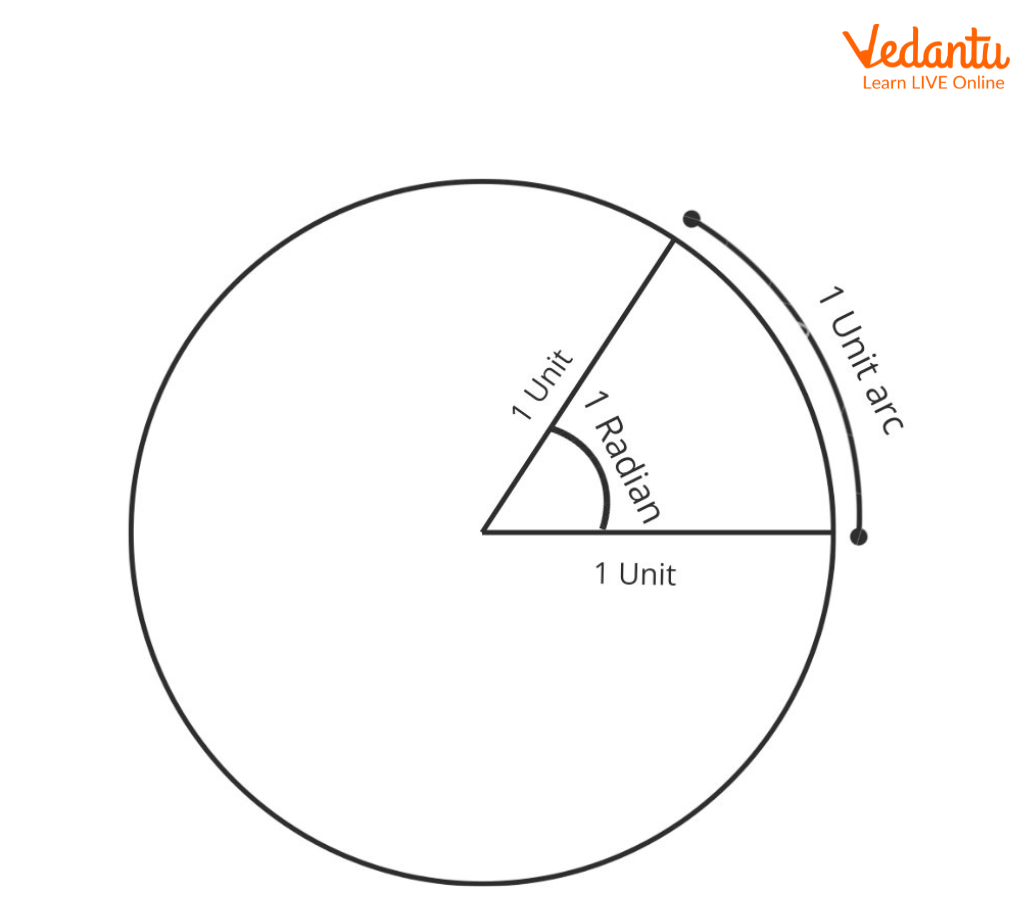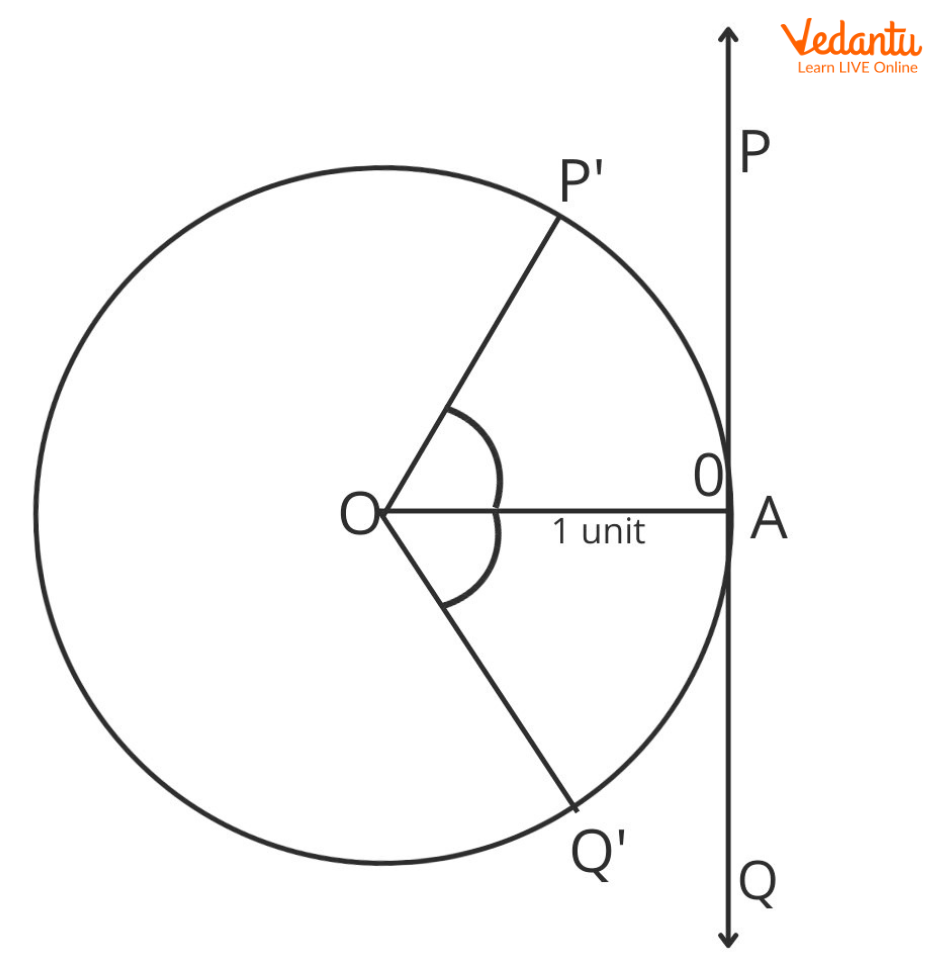




Introduction to Concept of Radian Measure
Radian Measure was introduced to relate the concept of measure of angle with the radius of a circle. The main benefit of radians is that we can represent radian measures with the help of real numbers. A circle is made up of \[2\pi \] radians, where one radian is equal to \[\dfrac{1}{6}\] of a circle approximately. The total angle of a circle in degrees is equal to \[{360^ \circ }\]. Hence, \[2\pi rad = {360^ \circ }\].
Definition of Radian Measure
Given a circle of radius one unit, consider an arc of length one unit. The angle subtended by the arc at the center of the circle is one radian. So, Radian Measure is a unit of measure of the angle.

Definition of Radian Measure
Mathematically, we can write:
Symbol of Radian Measure
The symbol of Radian Measure is rad or c.
Radian Measure Formula:
The formula for finding Angle subtended by Arc at the centre of circle in Radian Measure for given length of arc and radius of the circle is:
\[{\rm{Angle}}\left( {{\rm{Radian\;Measure}}} \right) = {\rm{\theta }} = \dfrac{{\text{Length of arc}}}{{\text{Radius}}} = \dfrac{l}{r}\] \[ = > l = r\theta \]
For example, Given Length of Arc l=2cm and the Radius of Circle r=1 cm, the Angle subtended by the Arc at the centre of circle is given by:
\[{\rm{Angle}}\left( {{\rm{Radian\;Measure}}} \right) = {\rm{\theta }} = \dfrac{{\text{Length of arc}}}{{\text{Radius}}} = \dfrac{l}{r}\]
\[\begin{array}{l} = \dfrac{{2cm}}{{1cm}}\\ = 1(R.M)\end{array}\]
Relation Between Radian Measure and Real Numbers
Every Real Number corresponds to the radian measure of some angle subtended by the arc at the centre of the circle.
Consider a circle centered O with a unit radius and consider a point A on the circumference of the circle. Draw a tangent to the circle at point A. Label this as line m, a line representing real numbers. Let the zero of the line m be at point A. Consider two points P and Q on opposite sides of point A.
Take a thread and measure the distance AP and cut it out, then, starting from A, start placing the cutting of the thread along the circumference of the circle in an Anti-Clockwise direction. Label this point as\[{\rm P}'\].Similarly, measure the same distance along the negative axis (\[AP = AQ\]). Now, take that thread and place it along the circumference of the circle in a Clockwise direction. Label that point as \[Q'\].

Radian Measure and Real Numbers
Here,\[AP = AQ\].
Through our construction,
Let \[\begin{array}{l}\angle AOP' = {\theta _1}\\\angle AOQ' = {\theta _2}\end{array}\]
Using Definition of angle, arc and radian.
So the lengths of arcs are related to the measure of the angle in radians and the values on the real line are equal to the lengths of arcs on the circle, we see that every real number corresponds to Radian Measure.
Relation Between Radian Measure and Degree Measure:
We know that a circle subtends a 360° angle at the center and its radian measure is 2π, so, 2π rad = 360°, which means π rad = 180°. Since value of π is \[\dfrac{{22}}{7}\], so
\[1rad=\dfrac{{180^{\circ}}}{\pi} = \dfrac{{180^{\circ }}}{\dfrac{22}{7}} = 57^{\circ} 16'\](approx.)
Now, \[1^\circ = \dfrac{\pi }{{180^\circ }} = 0.01746rad\](approx.)
So, the formulas for conversion of Degree Measure to Radian Measure and vice-versa are:
\[R.M = \dfrac{\pi }{{{{180}^ \circ }}} \times D.M.\]
and
\[D.M = \dfrac{{180^\circ }}{\pi } \times R.M.\]
Some Standard Angle Conversions
1 Radian is Equal To?
We know that
\[D.M = \dfrac{{180^\circ }}{\pi } \times R.M.\]
Given \[R.M. = 1\]
So, \[D.M. = \dfrac{{{{180}^ \circ }}}{\pi } \times 3 = \dfrac{{180^\circ }}{{\dfrac{{22}}{7}}} \times 3\]
\[ = \dfrac{{180^\circ }}{{22}} \times 7 \times 1 = \dfrac{{1260^\circ }}{{22}} = 57{\textstyle{3 \over {11}}}^\circ \]
As \[1^\circ = 60\min \],so,
\[\begin{array}{l}D.M. = 57^\circ + {\textstyle{3 \over {11}}}^\circ \\ = 57^\circ + ({\textstyle{3 \over {11}}}) \times 60'\\ = 57^\circ + ({\textstyle{{180} \over {11}}})'\\ = 57^\circ + 16{\textstyle{4 \over {11}}}'\\ = 57^\circ + 16' + {\textstyle{4 \over {11}}}'\end{array}\]
As \[1\min = 60\sec \],so,
\[\begin{array}{l}D.M. = 57^\circ + 16' + {\textstyle{4 \over {11}}} \times 60''\\ = 57^\circ + 16' + {\textstyle{{240} \over {11}}}''\\ = 57^\circ + 16' + 21.81''\\ \simeq 57^\circ 16'22''\end{array}\]
Hence, \[D.M.\]\[ = 57^\circ 16'22''\]
So, 1 rad is 57 degrees 16 minutes and 22 seconds.
Uses of Radian Measure:
Radian Measure relates Algebra to Trigonometry.
The trigonometric functions have simpler forms of derivatives when the angle is in Radian Measure. Otherwise, you will have to multiply a factor of \[{\textstyle{\pi \over {180}}}\]every time you need to find the derivative of such functions.
Since Radian Measure is connected to real numbers, we can easily represent any angle in form of a real numbered value.
Interesting Facts
There are about 6.28 radians in a complete revolution.
The Right angle is \[\dfrac{\pi }{2}\]rad.
The straight line is \[\pi\] rad.
We can use Radian Measure to find the length of the arc, area, and circumference of the sector made by the arc.
Length of arc \[l = r\theta \].
Area of sector made by Arc \[a = {\textstyle{1 \over 2}}{r^2}\theta \].
Perimeter of sector made by Arc \[p = l + 2r = r\theta + 2r = r(\theta + 2)\].
Radian Measure Examples With Solutions:
1. Convert 3 radians into Degree Measure.
Ans: We know that\[D.M = \dfrac{{180^\circ }}{\pi } \times R.M.\]
Given \[R.M. = 3\]
So, \[D.M. = \dfrac{{{{180}^ \circ }}}{\pi } \times 3 = \dfrac{{180^\circ }}{{\dfrac{{22}}{7}}} \times 3\]
\[ = \dfrac{{180^\circ }}{{22}} \times 7 \times 3 = 171{\textstyle{9 \over {11}}}^\circ \]
As \[1^\circ = 60\min \],so,
\[\begin{array}{l}D.M. = 171^\circ + {\textstyle{9 \over {11}}}^\circ \\ = 171^\circ + ({\textstyle{9 \over {11}}}) \times 60'\\ = 171^\circ + ({\textstyle{{540} \over {11}}})'\\ = 171^\circ + 49{\textstyle{1 \over {11}}}'\\ = 171^\circ + 49' + {\textstyle{1 \over {11}}}'\end{array}\]
As \[1\min = 60\sec \],so,
\[\begin{array}{l}D.M. = 171^\circ + 49' + {\textstyle{1 \over {11}}} \times 60''\\ = 171^\circ + 49' + {\textstyle{{60} \over {11}}}''\\ = 171^\circ + 49' + 5.45''\end{array}\]
Hence, \[D.M.\]\[ = 171^\circ 49'5.45''\] which is approximately \[171^\circ 49'6''\].
So, 3 Radians is 171 degrees 49 minutes and 6 seconds.
2. Convert 25° into Radians.
Ans: Given D.M.=25°.
\[R.M = \dfrac{\pi }{{{{180}^ \circ }}} \times D.M.\]
\[\begin{array}{l} = \dfrac{\pi }{{180^\circ }} \times 25^\circ \\ = \dfrac{{25\pi }}{{180}}\\ = \dfrac{{25 \times {\textstyle{{22} \over 7}}}}{{180}}\\ = \dfrac{{25 \times 22}}{{180 \times 7}}\\ = \dfrac{{550}}{{1260}}\\ = 0.436rad\end{array}\]
So, 25° is 0.436 rad.
3. Find the angle in radians and degrees through which a pendulum swings if its length is 75 cm and the tip describes an arc of length 15 cm.
Ans: Given the length of arc=l=15 cm.
Radius of arc=r=75 cm.
To find Angle subtended by arc in degrees.
As we know, \[{\rm{Angle}}\left( {{\rm{Radian\;Measure}}} \right) = {\rm{\theta }} = \dfrac{{\text{Length of arc}}}{{\text{Radius}}} = \dfrac{l}{r}\]
So, \[\theta = \dfrac{{15cm}}{{75cm}} = \dfrac{1}{5}rad\]
Also, \[D.M = \dfrac{{180^\circ }}{\pi } \times R.M.\]
\[ \Rightarrow D.M. = \dfrac{{180^\circ }}{\pi } \times \dfrac{1}{5}\]
\[ = \dfrac{{180^\circ }}{{5\pi }}\]
\[ = \dfrac{{180^\circ }}{{5 \times \dfrac{{22}}{7}}}\]
\[ = \dfrac{{180^\circ \times 7}}{{5 \times 22}}\]
\[ = \dfrac{{1260}}{{110}}\]
\[ = 114{\textstyle{6 \over {11}}}^\circ \]
\[\begin{array}{l} = 114^\circ + ({\textstyle{6 \over {11}}} \times 60)'\\ = 114^\circ + ({\textstyle{{360} \over {11}}})'\\ = 114^\circ + 32' + ({\textstyle{8 \over {11}}})'\\ = 114^\circ + 32' + ({\textstyle{8 \over {11}}} \times 60)''\\ = 114^\circ + 32' + ({\textstyle{{480} \over {11}}})''\\ = 114^\circ + 32' + 43.63''\\ = 114^\circ 32'43.63''\\ \simeq 114^\circ 32'44''\end{array}\]
So, the Radian Measure is \[\dfrac{1}{5}\]rad and Degree Measure is \[114^\circ 32'44''\].
Key Features
Radian Measure and Real numbers are equivalent quantities.
The Conversion formulas for Radian Measure and Degree Measure are:\[R.M = \dfrac{\pi }{{{{180}^ \circ }}} \times D.M.\] and\[D.M = \dfrac{{180^\circ }}{\pi } \times R.M.\]
- \[2\pi rad = {360^ \circ }\].
Practice Questions
Q1. Convert into Radian Measure: \[ - 15^\circ \].
Answer: \[-\dfrac{\pi}{12}\]
Q2. Convert into Degree Measure: \[4\pi\] rad.
Answer: \[720^\circ\]
FAQs on Radian Measure
1. What is the fundamental definition of radian measure in trigonometry?
A radian is the measure of a central angle (θ) in a circle that subtends an arc equal in length to the circle's radius (r). When the arc length (l) is exactly the same as the radius (l = r), the angle formed at the centre is precisely 1 radian. This system directly connects the angle's measure to the physical dimensions of the circle.
2. What is the primary formula used to calculate radian measure?
The formula that relates the central angle in radians (θ), the arc length (l), and the radius (r) of a circle is θ = l / r. This shows that the radian measure is a ratio of two lengths (arc length to radius), which is why it is a dimensionless quantity.
3. How do you convert an angle from degrees to radians and vice-versa?
To convert between degrees and radians, you use the core relationship that π radians = 180°. Based on this, the conversion methods are:
- Degrees to Radians: Multiply the angle in degrees by the factor (π / 180°).
- Radians to Degrees: Multiply the angle in radians by the factor (180° / π).
4. What are the radian measures for common angles like 90°, 180°, and 360°?
Using the standard conversion formula, the radian equivalents for key angles as per the CBSE syllabus are:
- A right angle (90°) is equal to π/2 radians.
- A straight angle (180°) is equal to π radians.
- A complete angle or full circle (360°) is equal to 2π radians.
5. What is the approximate value of 1 radian in terms of degrees?
Since we know that π radians = 180°, we can find the value of one radian by calculating 180°/π. Using the standard approximation for π, 1 radian is approximately 57.3° or, more precisely, 57° 17′ 45″.
6. Why is radian measure preferred over degrees in higher mathematics and physics?
Radian measure is preferred because it simplifies many important formulas, especially in calculus. For instance, the derivatives of trigonometric functions like sin(x) and cos(x) are simple and direct only when 'x' is measured in radians. It also creates a more natural relationship for formulas in topics like circular motion and wave phenomena.
7. What is the difference between a positive and a negative angle in radian measure?
The sign of an angle in radian measure indicates its direction of rotation from the initial side on the Cartesian plane.
- A positive angle signifies a counter-clockwise rotation from the positive x-axis.
- A negative angle signifies a clockwise rotation.
8. How does the concept of a unit circle simplify the understanding of radian measure?
A unit circle is a circle with a radius of 1 unit (r=1). When we use the radian formula θ = l/r on a unit circle, it simplifies to θ = l. This means, on a unit circle, the radian measure of a central angle is numerically equal to the length of the arc it subtends. This provides a powerful and intuitive visual tool for understanding the relationship between angles and trigonometric function values.






















